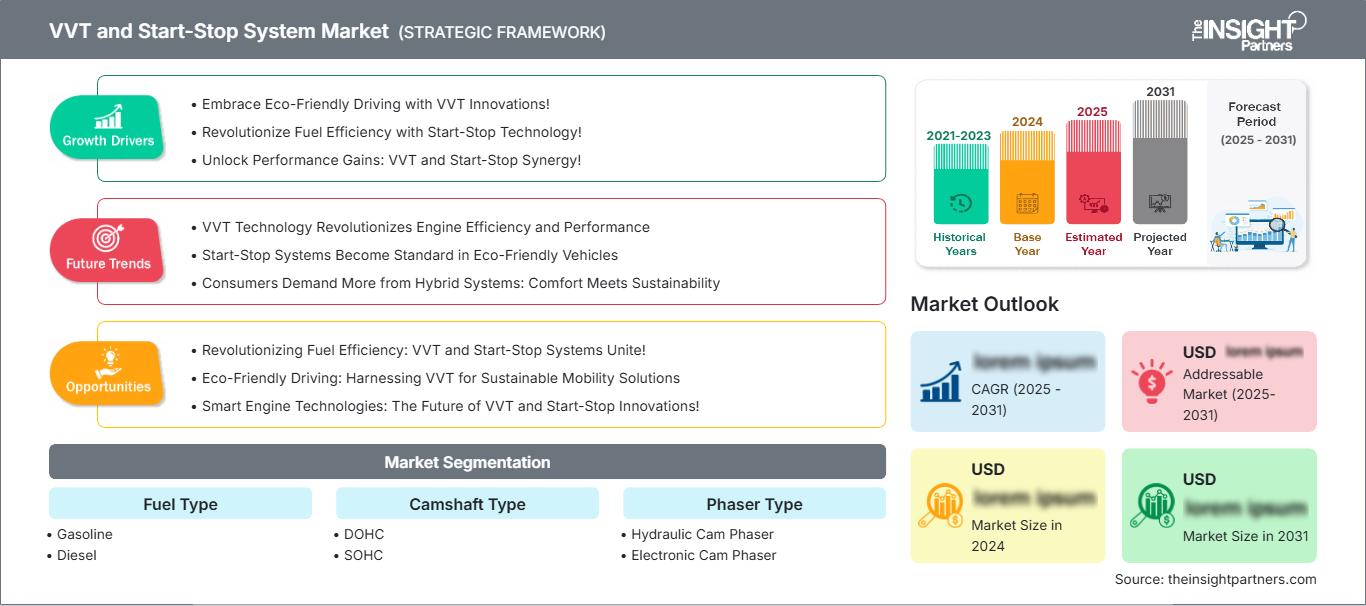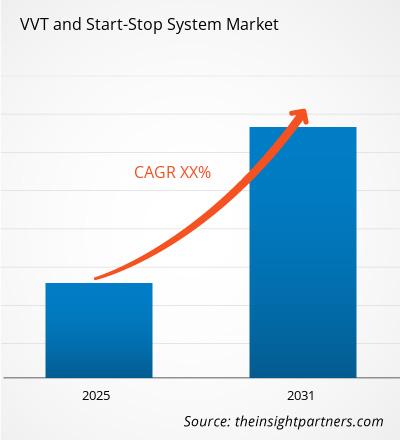Si prevede che il mercato dei sistemi VVT e Start-Stop registrerà un CAGR del XX% dal 2025 al 2031, con una dimensione del mercato in espansione da XX milioni di dollari nel 2024 a XX milioni di dollari entro il 2031.
Il rapporto è suddiviso in base al tipo di carburante (benzina, diesel) e analizza ulteriormente il mercato in base al tipo di albero a camme (DOHC, SOHC). Esamina inoltre il mercato in base al tipo di fasatore (fasatore a camme idraulico, fasatore a camme elettronico) e alla tecnologia di settore (alternatore con avviamento a cinghia, avviatore diretto, avviatore potenziato, generatore di avviamento integrato). Per ciascuno di questi segmenti chiave viene fornita una ripartizione completa a livello globale, regionale e nazionale. Il rapporto include le dimensioni del mercato e le previsioni per tutti i segmenti, presentando i valori in dollari statunitensi. Fornisce inoltre statistiche chiave sullo stato attuale del mercato dei principali attori, insieme ad approfondimenti sulle tendenze prevalenti e sulle opportunità emergenti.
Scopo del rapporto
Il rapporto VVT e Start-Stop System Market di The Insight Partners mira a descrivere il panorama attuale e la crescita futura, i principali fattori trainanti, le sfide e le opportunità. Ciò fornirà spunti a vari stakeholder aziendali, come:
- Fornitori/Produttori di tecnologia: per comprendere le dinamiche di mercato in evoluzione e conoscere le potenziali opportunità di crescita, consentendo loro di prendere decisioni strategiche informate.
- Investitori: per condurre un'analisi completa delle tendenze in merito al tasso di crescita del mercato, alle proiezioni finanziarie di mercato e alle opportunità esistenti lungo la catena del valore.
- Enti di regolamentazione: per regolamentare le politiche e le attività di controllo sul mercato con l'obiettivo di ridurre al minimo gli abusi, preservare la fiducia degli investitori e sostenere l'integrità e la stabilità del mercato.
Segmentazione del mercato dei sistemi VVT e Start-Stop Tipo di carburante
- Benzina
- Diesel
Tipo di albero a camme
- DOHC
- SOHC
Tipo di fasatore
- Fasatore a camme idraulico
- Fasatore a camme elettronico
Tecnologia
- Alternatore di avviamento a cinghia
- Avviamento diretto
- Avviamento migliorato
- Generatore di avviamento integrato
Potrai personalizzare gratuitamente qualsiasi rapporto, comprese parti di questo rapporto, o analisi a livello di paese, pacchetto dati Excel, oltre a usufruire di grandi offerte e sconti per start-up e università
Mercato dei sistemi VVT e Start-Stop: Approfondimenti strategici

- Ottieni le principali tendenze chiave del mercato di questo rapporto.Questo campione GRATUITO includerà l'analisi dei dati, che vanno dalle tendenze di mercato alle stime e alle previsioni.
Fattori di crescita del mercato dei sistemi VVT e Start-Stop
- Adotta una guida ecologica con le innovazioni VVT
- Rivoluziona l'efficienza del carburante con la tecnologia Start-Stop
- Sblocca i guadagni in termini di prestazioni: sinergia VVT e Start-Stop
Tendenze future del mercato dei sistemi VVT e Start-Stop
- La tecnologia VVT rivoluziona l'efficienza e le prestazioni del motore
- I sistemi Start-Stop diventano standard nei veicoli ecologici
- I consumatori chiedono di più dai sistemi ibridi: il comfort incontra la sostenibilità
Opportunità di mercato dei sistemi VVT e Start-Stop
- Rivoluzionare l'efficienza del carburante: i sistemi VVT e Start-Stop si uniscono
- Guida ecologica: Sfruttare la tecnologia VVT per soluzioni di mobilità sostenibile
- Tecnologie dei motori intelligenti: il futuro delle innovazioni VVT e Start-Stop
Mercato dei sistemi VVT e Start-Stop
Le tendenze e i fattori regionali che influenzano il mercato dei sistemi VVT e Start-Stop durante il periodo di previsione sono stati ampiamente spiegati dagli analisti di The Insight Partners. Questa sezione analizza anche i segmenti di mercato e la geografia dei sistemi VVT e Start-Stop in Nord America, Europa, Asia-Pacifico, Medio Oriente e Africa, America Meridionale e Centrale.
Ambito del rapporto di mercato sui sistemi VVT e Start-Stop
| Attributo del rapporto | Dettagli |
|---|---|
| Dimensioni del mercato in 2024 | US$ XX Million |
| Dimensioni del mercato per 2031 | US$ XX Million |
| CAGR globale (2025 - 2031) | XX% |
| Dati storici | 2021-2023 |
| Periodo di previsione | 2025-2031 |
| Segmenti coperti |
By Tipo di carburante
|
| Regioni e paesi coperti | Nord America
|
| Leader di mercato e profili aziendali chiave |
|
Densità degli operatori del mercato dei sistemi VVT e Start-Stop: comprendere il suo impatto sulle dinamiche aziendali
Il mercato dei sistemi VVT e Start-Stop è in rapida crescita, trainato dalla crescente domanda degli utenti finali, dovuta a fattori quali l'evoluzione delle preferenze dei consumatori, i progressi tecnologici e una maggiore consapevolezza dei vantaggi del prodotto. Con l'aumento della domanda, le aziende stanno ampliando la propria offerta, innovando per soddisfare le esigenze dei consumatori e sfruttando le tendenze emergenti, alimentando ulteriormente la crescita del mercato.

- Ottieni il Mercato dei sistemi VVT e Start-Stop Panoramica dei principali attori chiave
Punti di forza
- Copertura completa: il rapporto analizza in modo esaustivo prodotti, servizi, tipologie e utenti finali del mercato dei sistemi VVT e Start-Stop, fornendo una panoramica olistica.
- Analisi degli esperti: il rapporto è redatto sulla base della conoscenza approfondita di esperti e analisti del settore.
- Informazioni aggiornate: il rapporto garantisce la pertinenza aziendale grazie alla copertura di informazioni e tendenze dei dati recenti.
- Opzioni di personalizzazione: questo rapporto può essere personalizzato per soddisfare le esigenze specifiche del cliente e adattarsi in modo appropriato alle strategie aziendali.
Il rapporto di ricerca sul mercato dei sistemi VVT e Start-Stop può quindi contribuire a guidare il percorso di decodificazione e comprensione dello scenario del settore e delle prospettive di crescita. Sebbene possano esserci alcune preoccupazioni valide, i vantaggi complessivi di questo rapporto tendono a superare gli svantaggi.
- Analisi storica (2 anni), anno base, previsione (7 anni) con CAGR
- Analisi PEST e SWOT
- Valore/volume delle dimensioni del mercato - Globale, Regionale, Nazionale
- Industria e panorama competitivo
- Set di dati Excel
Report recenti
Testimonianze
Motivo dell'acquisto
- Processo decisionale informato
- Comprensione delle dinamiche di mercato
- Analisi competitiva
- Analisi dei clienti
- Previsioni di mercato
- Mitigazione del rischio
- Pianificazione strategica
- Giustificazione degli investimenti
- Identificazione dei mercati emergenti
- Miglioramento delle strategie di marketing
- Aumento dell'efficienza operativa
- Allineamento alle tendenze normative




















 Ottieni un campione gratuito per - Mercato dei sistemi VVT e Start-Stop
Ottieni un campione gratuito per - Mercato dei sistemi VVT e Start-Stop